JAGUAR XJ 2004 X350 / 3.G Repair Manual
Manufacturer: JAGUAR, Model Year: 2004, Model line: XJ, Model: JAGUAR XJ 2004 X350 / 3.GPages: 227, PDF Size: 4.22 MB
Page 61 of 227
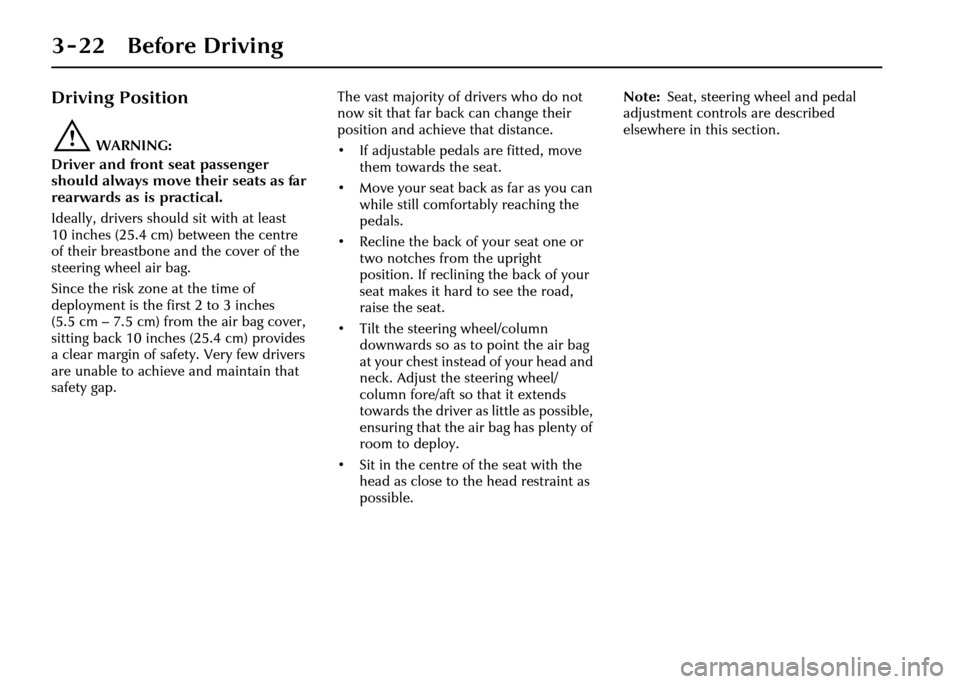
3 - 22 Before Driving
Driving Position
!WARNING:
Driver and front seat passenger
should always move their seats as far
rearwards as is practical.
Ideally, drivers should sit with at least
10 inches (25.4 cm) between the centre
of their breastbone and the cover of the
steering wheel air bag.
Since the risk zone at the time of
deployment is the first 2 to 3 inches
(5.5 cm – 7.5 cm) from the air bag cover,
sitting back 10 inches (25.4 cm) provides
a clear margin of safety. Very few drivers
are unable to achieve and maintain that
safety gap. The vast majority of drivers who do not
now sit that far back can change their
position and achieve that distance.
• If adjustable pedals are fitted, move
them towards the seat.
• Move your seat back as far as you can while still comfortably reaching the
pedals.
• Recline the back of your seat one or two notches from the upright
position. If reclining the back of your
seat makes it hard to see the road,
raise the seat.
• Tilt the steering wheel/column downwards so as to point the air bag
at your chest instead of your head and
neck. Adjust the steering wheel/
column fore/aft so that it extends
towards the driver as little as possible,
ensuring that the air bag has plenty of
room to deploy.
• Sit in the centre of the seat with the head as close to the head restraint as
possible. Note:
Seat, steering wheel and pedal
adjustment controls are described
elsewhere in this section.
Page 62 of 227
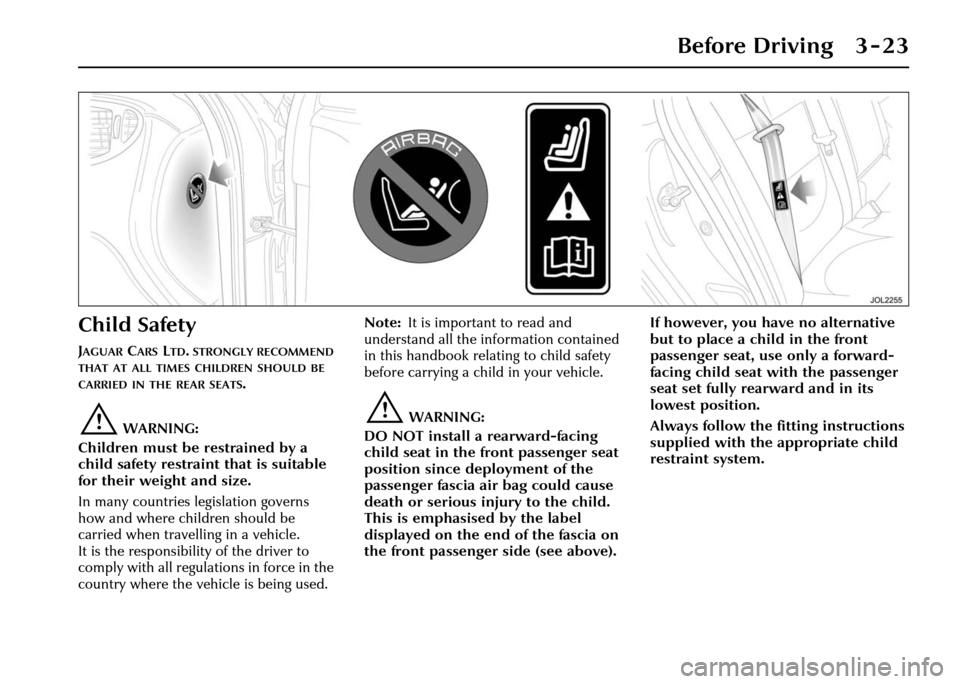
Before Driving 3 - 23
Child Safety
JAGUARCARSLTD. STRONGLY RECOMMEND
THAT AT ALL TIMES CHILDREN SHOULD BE
CARRIED IN THE REAR SEATS.
!WARNING:
Children must be restrained by a
child safety restraint that is suitable
for their weight and size.
In many countries legislation governs
how and where children should be
carried when travelling in a vehicle.
It is the responsibility of the driver to
comply with all regulations in force in the
country where the vehicle is being used. Note:
It is important to read and
understand all the information contained
in this handbook rela ting to child safety
before carrying a child in your vehicle.
!WARNING:
DO NOT install a rearward-facing
child seat in the fr ont passenger seat
position since deployment of the
passenger fascia air bag could cause
death or serious injury to the child.
This is emphasised by the label
displayed on the end of the fascia on
the front passenger side (see above). If however, you hav
e no alternative
but to place a child in the front
passenger seat, use only a forward-
facing child seat with the passenger
seat set fully rearward and in its
lowest position.
Always follow the fitting instructions
supplied with the appropriate child
restraint system.
Page 63 of 227
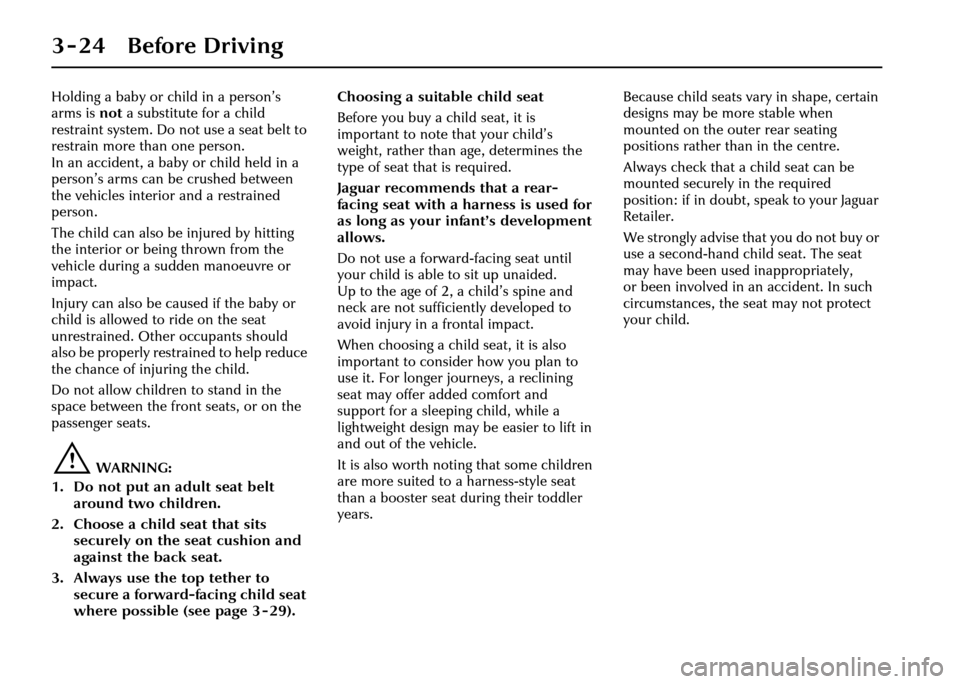
3 - 24 Before Driving
Holding a baby or child in a person’s
arms is not a substitute for a child
restraint system. Do not use a seat belt to
restrain more than one person.
In an accident, a baby or child held in a
person’s arms can be crushed between
the vehicles interior and a restrained
person.
The child can also be injured by hitting
the interior or being thrown from the
vehicle during a sudden manoeuvre or
impact.
Injury can also be caused if the baby or
child is allowed to ride on the seat
unrestrained. Other occupants should
also be properly restra ined to help reduce
the chance of injuring the child.
Do not allow children to stand in the
space between the front seats, or on the
passenger seats.
!WARNING:
1. Do not put an adult seat belt around two children.
2. Choose a child seat that sits
securely on the seat cushion and
against the back seat.
3. Always use the top tether to secure a forward-facing child seat
where possible (see page 3 - 29). Choosing a suitable child seat
Before you buy a child seat, it is
important to note that your child’s
weight, rather than age, determines the
type of seat that is required.
Jaguar recommends that a rear-
facing seat with a harness is used for
as long as your infant’s development
allows.
Do not use a forward-facing seat until
your child is able to sit up unaided.
Up to the age of 2, a child’s spine and
neck are not sufficiently developed to
avoid injury in a frontal impact.
When choosing a child seat, it is also
important to consider how you plan to
use it. For longer journeys, a reclining
seat may offer a
dded comfort and
support for a sleepin g child, while a
lightweight design may be easier to lift in
and out of the vehicle.
It is also worth noting that some children
are more suited to a harness-style seat
than a booster seat during their toddler
years. Because child seats vary in shape, certain
designs may be more stable when
mounted on the ou
ter rear seating
positions rather than in the centre.
Always check that a child seat can be
mounted securely in the required
position: if in doubt, speak to your Jaguar
Retailer.
We strongly advise that you do not buy or
use a second-hand child seat. The seat
may have been used inappropriately,
or been involved in an accident. In such
circumstances, the seat may not protect
your child.
Page 64 of 227
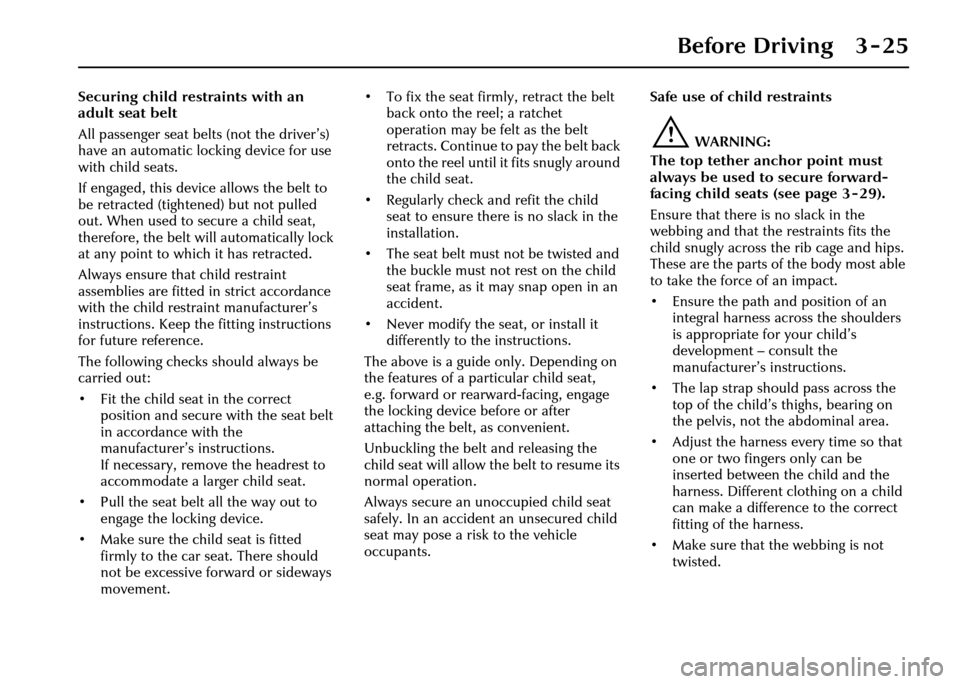
Before Driving 3 - 25
Securing child restraints with an
adult seat belt
All passenger seat belts (not the driver’s)
have an automatic locking device for use
with child seats.
If engaged, this device allows the belt to
be retracted (tightened) but not pulled
out. When used to secure a child seat,
therefore, the belt will automatically lock
at any point to which it has retracted.
Always ensure that child restraint
assemblies are fitted in strict accordance
with the child restraint manufacturer’s
instructions. Keep the fitting instructions
for future reference.
The following checks should always be
carried out:
• Fit the child seat in the correct position and secure with the seat belt
in accordance with the
manufacturer’s instructions.
If necessary, remove the headrest to
accommodate a larger child seat.
• Pull the seat belt all the way out to engage the locking device.
• Make sure the child seat is fitted firmly to the car seat. There should
not be excessive forward or sideways
movement. • To fix the seat firm
ly, retract the belt
back onto the reel; a ratchet
operation may be felt as the belt
retracts. Continue to pay the belt back
onto the reel until it fits snugly around
the child seat.
• Regularly check and refit the child seat to ensure there is no slack in the
installation.
• The seat belt must not be twisted and
the buckle must not rest on the child
seat frame, as it may snap open in an
accident.
• Never modify the seat, or install it differently to the instructions.
The above is a guide only. Depending on
the features of a particular child seat,
e.g. forward or rearwa rd-facing, engage
the locking device before or after
attaching the belt, as convenient.
Unbuckling the belt and releasing the
child seat will allow th e belt to resume its
normal operation.
Always secure an unoccupied child seat
safely. In an accident an unsecured child
seat may pose a risk to the vehicle
occupants. Safe use of child restraints
!WARNING:
The top tether anchor point must
always be used to secure forward-
facing child seats (see page 3 - 29).
Ensure that there is no slack in the
webbing and that the restraints fits the
child snugly across the rib cage and hips.
These are the parts of the body most able
to take the force of an impact.
• Ensure the path and position of an integral harness across the shoulders
is appropriate for your child’s
development – consult the
manufacturer’s instructions.
• The lap strap should pass across the top of the child’s thighs, bearing on
the pelvis, not the abdominal area.
• Adjust the harness every time so that one or two fingers only can be
inserted between the child and the
harness. Different clothing on a child
can make a difference to the correct
fitting of the harness.
• Make sure that the webbing is not twisted.
Page 65 of 227
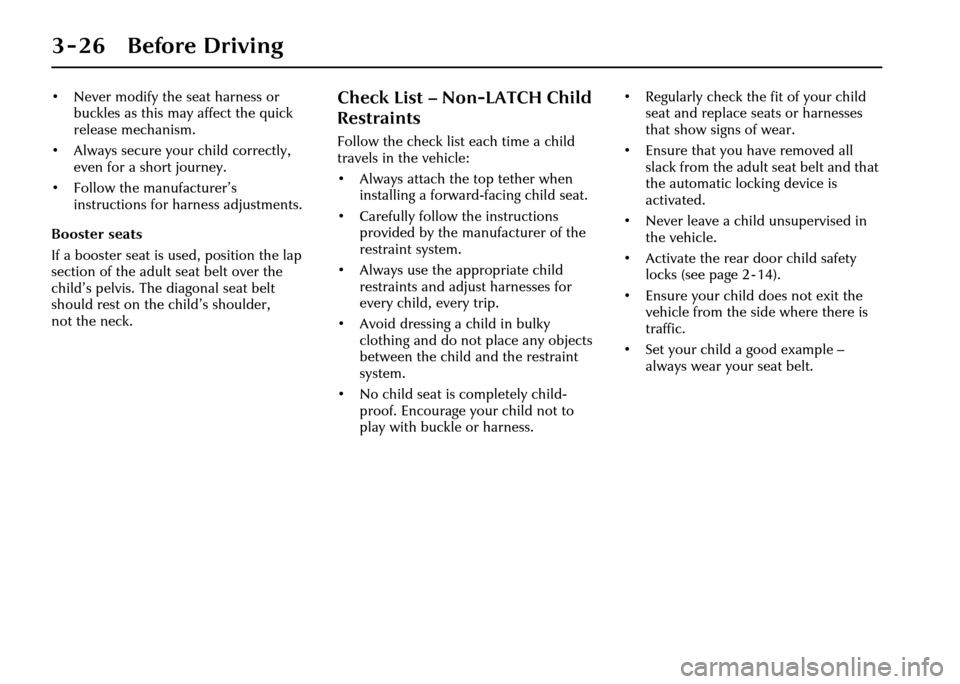
3 - 26 Before Driving
• Never modify the seat harness or buckles as this may affect the quick
release mechanism.
• Always secure your child correctly, even for a short journey.
• Follow the manufacturer’s instructions for harness adjustments.
Booster seats
If a booster seat is used, position the lap
section of the adult seat belt over the
child’s pelvis. The diagonal seat belt
should rest on the child’s shoulder,
not the neck.Check List – Non-LATCH Child
Restraints
Follow the check list each time a child
travels in the vehicle:
• Always attach the top tether when
installing a forward-facing child seat.
• Carefully follow the instructions provided by the manufacturer of the
restraint system.
• Always use the appropriate child restraints and adjust harnesses for
every child, every trip.
• Avoid dressing a child in bulky clothing and do not place any objects
between the child and the restraint
system.
• No child seat is completely child- proof. Encourage your child not to
play with buckle or harness. • Regularly check the fit of your child
seat and replace seats or harnesses
that show signs of wear.
• Ensure that you have removed all slack from the adult seat belt and that
the automatic locking device is
activated.
• Never leave a child unsupervised in the vehicle.
• Activate the rear door child safety locks (see page 2 - 14).
• Ensure your child does not exit the vehicle from the side where there is
traffic.
• Set your child a good example – always wear your seat belt.
Page 66 of 227
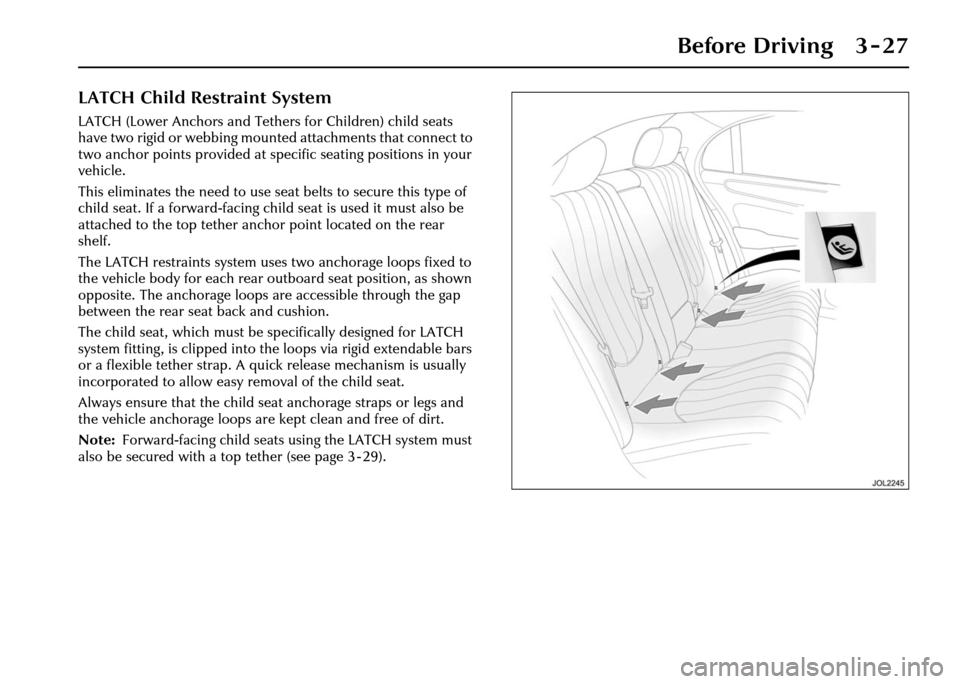
Before Driving 3 - 27
LATCH Child Restraint System
LATCH (Lower Anchors and Tethers for Children) child seats
have two rigid or webbing mounted attachments that connect to
two anchor points provided at specific seating positions in your
vehicle.
This eliminates the need to use seat belts to secure this type of
child seat. If a forward-facing child seat is used it must also be
attached to the top tether anch or point located on the rear
shelf.
The LATCH restraints system uses two anchorage loops fixed to
the vehicle body for each rear outboard seat position, as shown
opposite. The anchorage loops are accessible through the gap
between the rear seat back and cushion.
The child seat, which must be sp ecifically designed for LATCH
system fitting, is clipped into the loops via rigid extendable bars
or a flexible tether strap. A quick release mechanism is usually
incorporated to allow easy removal of the child seat.
Always ensure that the child seat anchorage straps or legs and
the vehicle anchorage loops are kept clean and free of dirt.
Note: Forward-facing child seats using the LATCH system must
also be secured with a top tether (see page 3 - 29).
Page 67 of 227

3 - 28 Before Driving
Fitting LATCH seats
For further information regarding a LATCH child seat, please
consult your Jaguar Retailer.
Always use the additional top tether anchorage.
LATCH child seats can only be fi tted to the two outer rear seat
positions, as shown on the previous page.
Caution: When fitting a LATCH child seat, the seat
manufacturers instructions must always be followed.
The following is a guide only.
Note: So as not to interfere with the fitment of large child seats,
push the adult seat buckles into their buckle recesses and,
if necessary, remove the headrest.
LATCH seat with extendable bars (A) – Fit the seat as
follows:
1. Expose the LATCH loops between the seat and seat back.
2. Make sure that the adult seat belts and buckles do not become trapped behind the child seat.
3. Make sure there is nothing obstructing the seat mounting mechanism at the anchorage points.
4. Make sure you do NOT trap the top tether strap behind the child seat.
5. Fully extend the two attachme nt bars on the child seat
(see manufacturer’s instructions).
6. Locate the slots on the ends of the bars onto the two LATCH
loops, then push the seat asse mbly rearwards until the bars
are positively engaged (a trigger operates to lock the
attachment bars onto the loops). 7. Slide the seat rearwards along the legs until it is locked firmly
against the vehicle seat back. Confirm that it is securely
locked in position.
8. Secure a forward-facing ch ild seat to the top tether
anchorage.
LATCH seat with tether straps (B) – Clip the flexible lower
straps to the two LATCH loops. Adjust the length of each strap
until the seat is held firmly against the vehicle seat back.
!WARNING:
Do not install a LATCH child seat with flexible lower
attachments in the vehicle centre seat position.
The anchorage loops are only provided to install a
compatible child seat in the vehicle outboard seat
positions.
Page 68 of 227
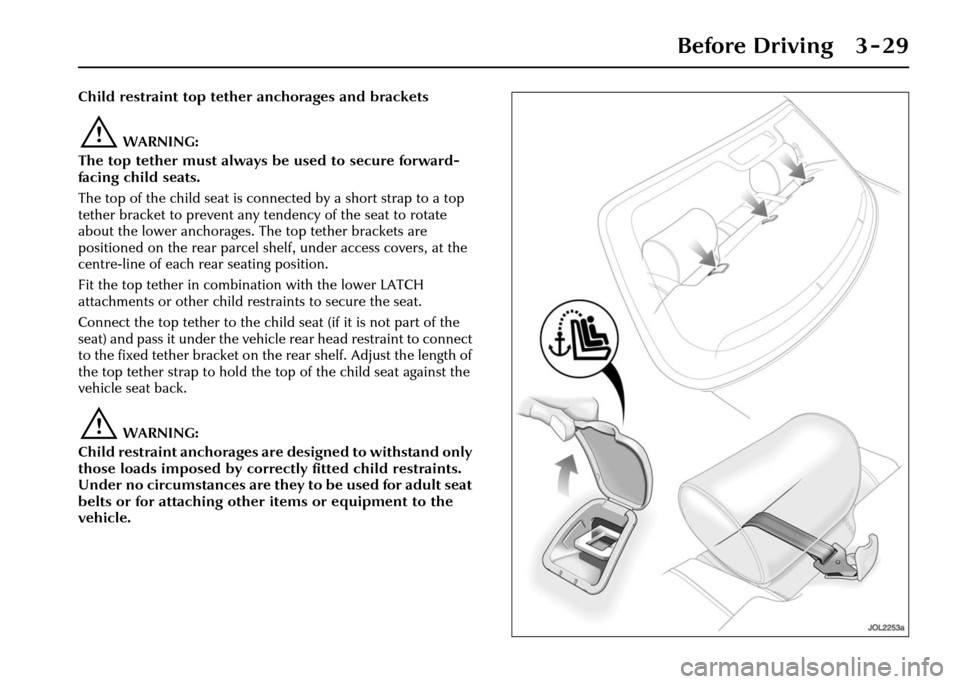
Before Driving 3 - 29
Child restraint top tether anchorages and brackets
!WARNING:
The top tether must always be used to secure forward-
facing child seats.
The top of the child seat is connected by a short strap to a top
tether bracket to prevent any tendency of the seat to rotate
about the lower anchorages. The top tether brackets are
positioned on the rear parcel shelf, under access covers, at the
centre-line of each rear seating position.
Fit the top tether in combination with the lower LATCH
attachments or other child restraints to secure the seat.
Connect the top tether to the child seat (if it is not part of the
seat) and pass it under the vehicle rear head restraint to connect
to the fixed tether bracket on the rear shelf. Adjust the length of
the top tether strap to hold the top of the child seat against the
vehicle seat back.
!WARNING:
Child restraint anchorages are designed to withstand only
those loads imposed by correctly fitted child restraints.
Under no circumstances are they to be used for adult seat
belts or for attaching other items or equipment to the
vehicle.
Page 69 of 227
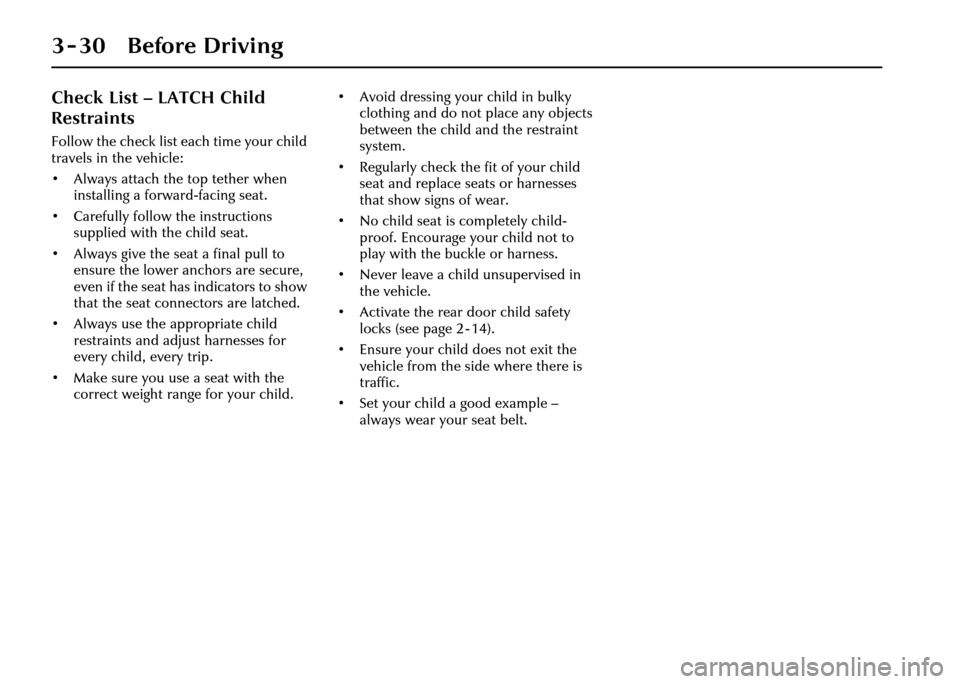
3 - 30 Before Driving
Check List – LATCH Child
Restraints
Follow the check list each time your child
travels in the vehicle:
• Always attach the top tether when installing a forward-facing seat.
• Carefully follow the instructions supplied with the child seat.
• Always give the seat a final pull to ensure the lower anchors are secure,
even if the seat has indicators to show
that the seat connectors are latched.
• Always use the appropriate child restraints and adjust harnesses for
every child, every trip.
• Make sure you use a seat with the correct weight range for your child. • Avoid dressing your child in bulky
clothing and do not place any objects
between the child and the restraint
system.
• Regularly check the fit of your child seat and replace seats or harnesses
that show signs of wear.
• No child seat is completely child- proof. Encourage your child not to
play with the buckle or harness.
• Never leave a child unsupervised in the vehicle.
• Activate the rear door child safety locks (see page 2 - 14).
• Ensure your child does not exit the vehicle from the side where there is
traffic.
• Set your child a good example – always wear your seat belt.
Page 70 of 227
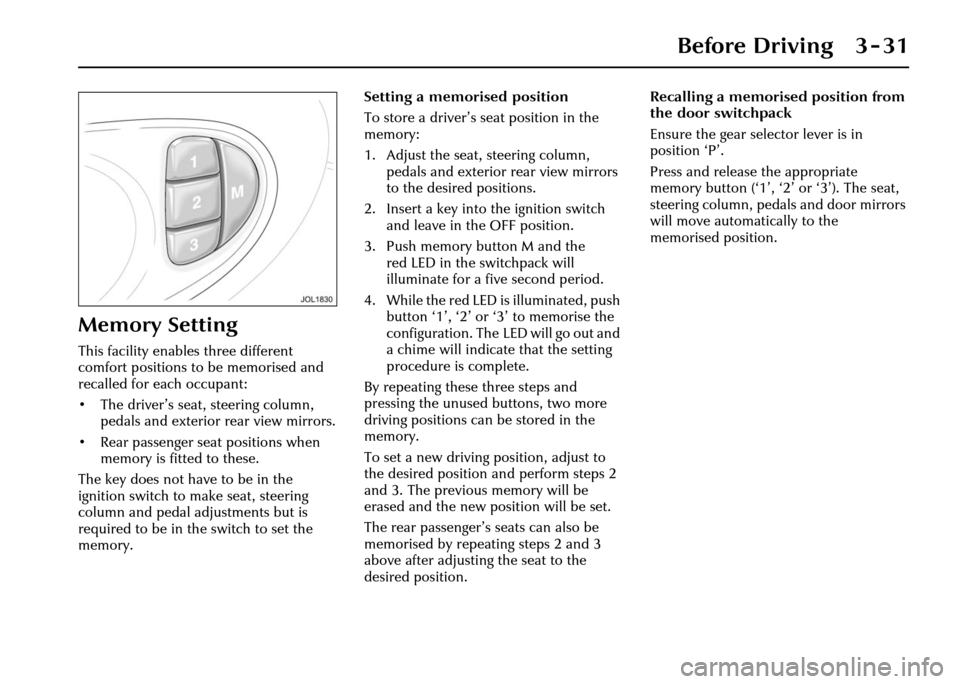
Before Driving 3 - 31
Memory Setting
This facility enables three different
comfort positions to be memorised and
recalled for each occupant:
• The driver’s seat, steering column, pedals and exterior rear view mirrors.
• Rear passenger seat positions when memory is fitted to these.
The key does not have to be in the
ignition switch to make seat, steering
column and pedal adjustments but is
required to be in th e switch to set the
memory. Setting a memorised position
To store a driver’s seat position in the
memory:
1. Adjust the seat, steering column,
pedals and exterior rear view mirrors
to the desired positions.
2. Insert a key into the ignition switch and leave in the OFF position.
3. Push memory button M and the red LED in the switchpack will
illuminate for a five second period.
4. While the red LED is illuminated, push button ‘1’, ‘2’ or ‘3’ to memorise the
configuration. The LED will go out and
a chime will indicate that the setting
procedure is complete.
By repeating these three steps and
pressing the unused buttons, two more
driving positions can be stored in the
memory.
To set a new driving position, adjust to
the desired position and perform steps 2
and 3. The previous memory will be
erased and the new position will be set.
The rear passenger’s seats can also be
memorised by repeating steps 2 and 3
above after adjusting the seat to the
desired position. Recalling a memorise
d position from
the door switchpack
Ensure the gear selector lever is in
position ‘P’.
Press and release the appropriate
memory button (‘1’, ‘2’ or ‘3’). The seat,
steering column, pedals and door mirrors
will move automatically to the
memorised position.